ARKAS CARPET COLLECTION
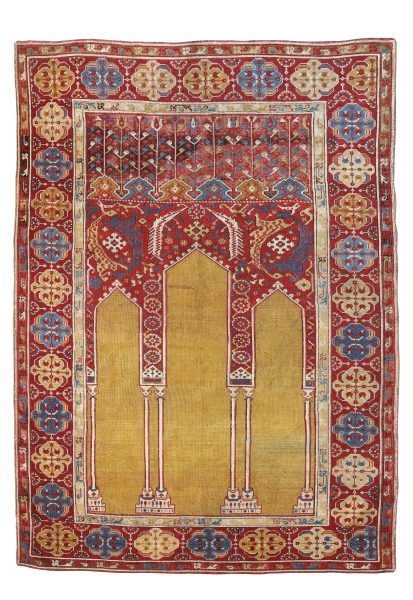
Transylvanian Column Rug, Kula, Mid-17th c., Wool, Inv. No: 386
This exceptionally beautiful column rug belongs to the rarest type of so called ‘Transylvanian’ group, after the name of the region, where the largest number of similar rugs survive today. The architectural layout, was introduced in by the Cairo-Ottoman prayer rugs, designed by the nakkashane artists for the imperial court. The rug has a clear design and vibrant palette dominated by the golden-yellow niches, surmounted by the red arcade with crenelated frieze and tulips. The Arkas prayer rug shows a triple arcade decorated with centrally placed lancet leaves, flanked by paired arabesque leaves enclosing a cogwheel rosette. The red arcade is supported by columns with finely drawn bases. The field is framed by a cusped medallion border.

Small Medallion Rug, Uşak, 16th c., Wool, Inv. No: 327
This is a classical Small-Medallion Uşak, with a central hexagonal medallion against the deep-red ground, and arabesque spandrels; these are in fact quarters of a four-lobed medallion, which can be traced to Ottoman bookbinding and further to Timurid art. Together, the four corner pieces in the field give the impression of a ‘sheep-skin’. The elegant main border consists of ivory cloud bands, borrowed from Chinese art, alternating with six-tooth rosettes on a deep blue ground. This pattern is common to small-medallion Uşaks, to ‘Lotto’ rugs and to ‘Bird’ rugs. Interestingly, the cloud bands found in the borders of several types of western Anatolian rugs have a ligature uniting the two halves, in contrast to those seen in the spandrels, which are open.
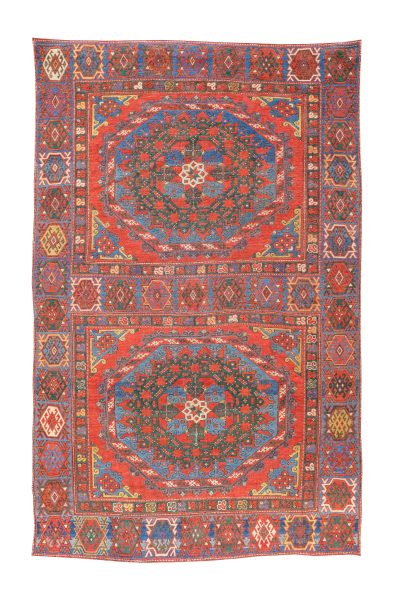
Large Pattern Holbein Rug, West Anatolia, Circa 1465, Wool, Inv. No: 562
Notoriously, Anatolian textile art is anonymous, and little is known about the weavers; therefore, several groups of classical carpets have been conventionally linked in carpet literature to the names of artists who included them in their paintings. The field of this carpet, which was named after the painter Hans Holbein, is divided into two panels, containing the distinctive large medallion of complex design, which is centered by an eight-pointed star with white interlace. The corners of the panels are relatively elaborate, consisting of an endless knot in red within blue and yellow scrollwork. The motifs of the main border are beautifully articulated; their unusual angles are achieved with extensive use of offset knotting, indicating a sophisticated approach to rendering slanted lines in the design.

Star Uşak, Early 17th century, Wool, Inv. No: 358
The field design shows a section of the endless repeat pattern, formed by offset rows of eight-lobed star medallions (two full medallions placed centrally) alternating with smaller secondary diamonds on a red ground. The space between the medallions is filled with floral motifs. The main border consists of a so-called ‘Gothic’ border for a certain resemblance with the arches of the Gothic cathedrals. This pattern composed meandering stem with attached leaves that form arches, similar to the reciprocal ‘V’ shaped bands used for framing the pages in illuminated manuscripts or motifs found in Safavid miniature painting. Their association in European painting with royalty and sanctity underscores the status these carpets enjoyed as luxury trade goods.

Lotto Rug with Box Border, Uşak, Second half of 16th century, Wool, Inv. No: 307
This elegant Lotto rug, showing ‘Anatolian’ style field (with a column of four cruciform arabesques placed centrally) and Kufic-derived box border, can still be ascribed to the 16th century. The ‘Boxes’ in the border, with four inward pairs of ‘ram’s horns, forming four arrows describing an ‘X’, is common to ‘Holbein’, ‘Lotto’ and ‘Bellini’ rugs; in the early types as the Arkas example, there is an eight-pointed rosette in the center that volutes between the boxes. A clear reference for this border type can be found in the painting “The Chess Players, circa 1590” by Ludovico Carracci (1555-1619) – an Italian master born in Bologna, who often depicted religious themes – from Gemäldegalerie, Berlin. The table is covered by an ‘Anatolian’ style ‘Lotto’ rug with the field perfectly fitting the table. The ‘Box’ border pattern can be ascribed to closed Kufic-derived pattern.
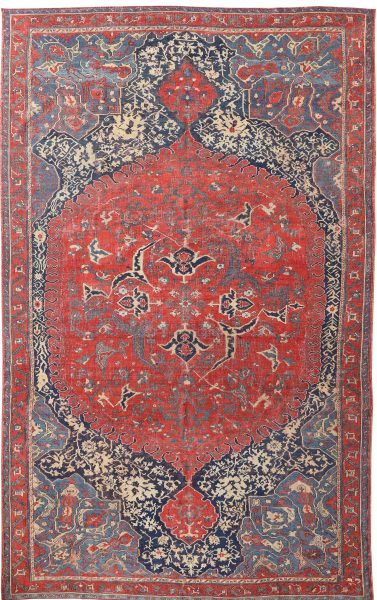
Large Medallion Uşak, Second half of 16th century, Wool, Inv. No: 518
This magnificent Uşak shows a squashed medallion against a red field, enclosed by two pendants and sections of secondary medallions at the sides. Typically, the blue medallion, decorated with a floral composition, is outlined by arabesques. The four quarter-medallions placed at the top and bottom give the impression of an infinite design, lending majesty to the installation. The rich color scheme is dominated by red, blue, and black with vibrant accents of green and yellow. The main border reflects a typical floral pattern, often found in Uşak carpets, with red palmettes and floral branches placed diagonally against an indigo ground.

Four-Octagons Gül Carpet, Early 16th century, Wool, Inv. No: 540
This remarkable rug is the very best and earliest example of an important design group of Anatolian rugs.This motif is composed of a central square surrounded by four octagons, forming a large cross, with additional rectangular shapes added to the four corners, making the motif resemble an eight-lobed medallion. We believe that few surviving examples are all from different villages and possibly were made over a period spanning more than a century.
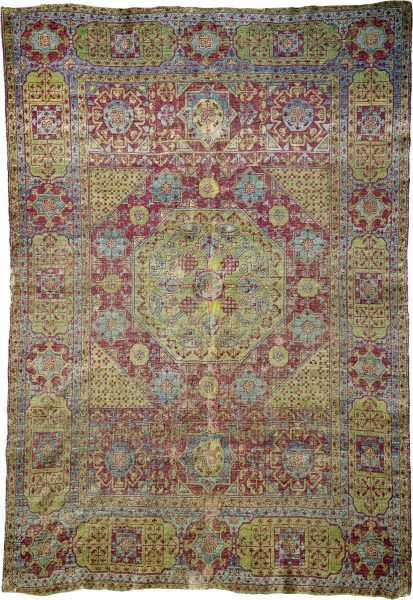
Mamluk Rug, Egypt, Cairo, 1525-1550, Wool, Inv. No: 308
Mamluk carpets were woven probably in Cairene workshops in the last period of the Mamluk Sultanate which reigned over Egypt, Syria and Palestine from 1250 until 1517, when it was defeated by the Ottoman Empire. Often mentioned as cairini or cagiarini (meaning “Cairene”, “from Cairo”), these carpets were well known and appreciated in Italy in the second half of the 15th century. However, it was only in the 1930s that Mamluk carpets were clearly identified as a group, distinct from that of Turkish-Anatolian production due to the specific technical peculiarities. The design of these rugs is characterized by centralized the large octagonal, lobed or star shaped medallions displaying a rich, minute ornamentation with kaleidoscopic effect, containing a great variety of peculiar motifs such as the small umbrella leaves that resemble papyrus leaves.
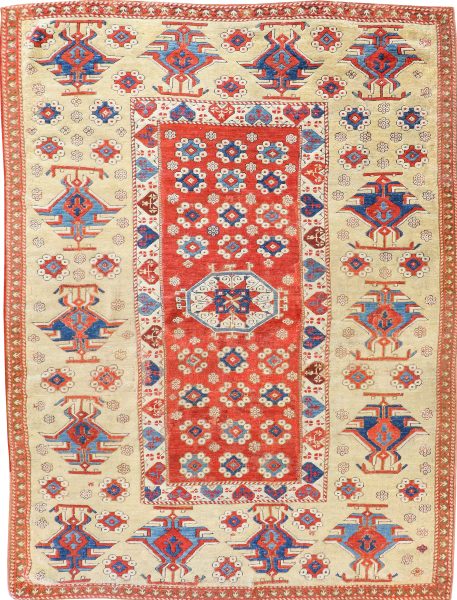
Village Rug with Stylized Palmette Border, Bergama, early 18th century, Wool, Inv. No: 563
This iconic rug belongs to a small group of the 17th or the 18th century Anatolian village weavings with wide border showing highly stylized motifs. The narrow field panel displays rosettes of two scales, arranged in offset rows, and an octagonal medallion with white interlaces and a central 8-pointed red star, reminiscent of large-pattern ‘Holbein’ carpets. The inner white-ground minor border framing the field shows heart-shaped motifs, containing small tulips and carnations. Visually, the composition is dominated by the wide main border with stylized palmettes against a pale-yellow ground, which is distinctive to the group.


